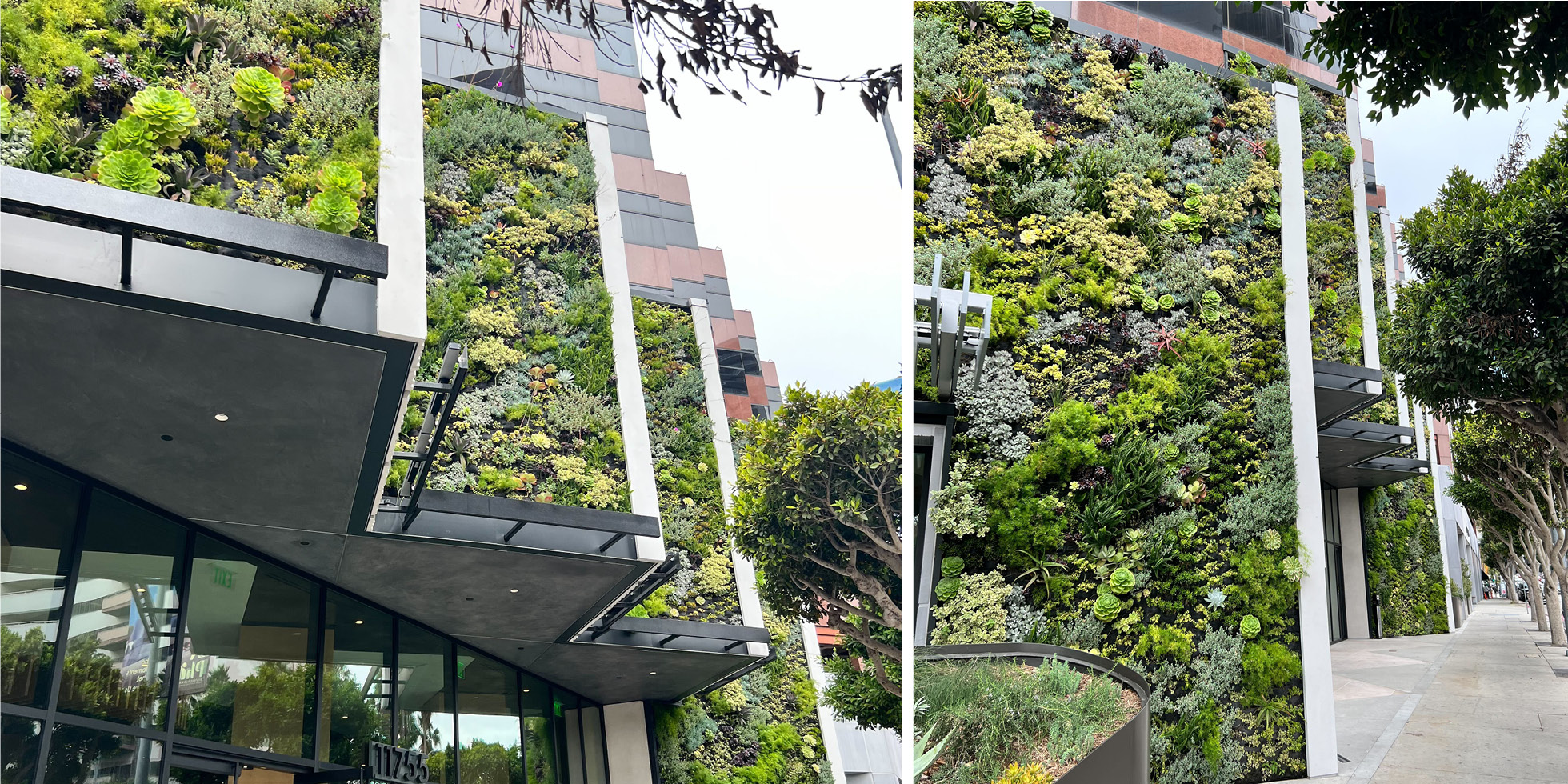11755 Wilshire


These living walls were thoughtfully designed to thrive in the intense, south-facing Los Angeles sun, utilizing drought-tolerant, low-maintenance plant species that ensure both resilience and longevity. Beyond their visual appeal, the walls deliver real environmental benefits—thermal imaging revealed that the planted surface was 40°F cooler than the adjacent unplanted facade, significantly reducing the building’s heat load and improving the surrounding microclimate. Despite their hardy nature, the walls feel lush and vibrant, featuring a rich mix of soft ferns, flowering perennials, and bold succulents such as Mangave and Dudleya. With 22 plant species and over 8,200 individual plants, the design forms an ever-changing natural tapestry. Its organic, non-repetitive layout reveals new patterns and colors throughout the year as different species bloom, offering a dynamic and evolving visual experience. Flowering plants were selected not only for beauty but also to attract bees, butterflies, and other vital pollinators, enhancing local biodiversity. To elevate the visual impact further, unique sculptural succulents were strategically placed as focal points, creating striking structural highlights across the design.

Heading

Heading

Heading

Heading

Heading

Heading

Heading

Heading

Heading

Heading



These living walls were thoughtfully designed to thrive in the intense, south-facing Los Angeles sun, utilizing drought-tolerant, low-maintenance plant species that ensure both resilience and longevity. Beyond their visual appeal, the walls deliver real environmental benefits—thermal imaging revealed that the planted surface was 40°F cooler than the adjacent unplanted facade, significantly reducing the building’s heat load and improving the surrounding microclimate. Despite their hardy nature, the walls feel lush and vibrant, featuring a rich mix of soft ferns, flowering perennials, and bold succulents such as Mangave and Dudleya. With 22 plant species and over 8,200 individual plants, the design forms an ever-changing natural tapestry. Its organic, non-repetitive layout reveals new patterns and colors throughout the year as different species bloom, offering a dynamic and evolving visual experience. Flowering plants were selected not only for beauty but also to attract bees, butterflies, and other vital pollinators, enhancing local biodiversity. To elevate the visual impact further, unique sculptural succulents were strategically placed as focal points, creating striking structural highlights across the design.













These living walls were thoughtfully designed to thrive in the intense, south-facing Los Angeles sun, utilizing drought-tolerant, low-maintenance plant species that ensure both resilience and longevity. Beyond their visual appeal, the walls deliver real environmental benefits—thermal imaging revealed that the planted surface was 40°F cooler than the adjacent unplanted facade, significantly reducing the building’s heat load and improving the surrounding microclimate. Despite their hardy nature, the walls feel lush and vibrant, featuring a rich mix of soft ferns, flowering perennials, and bold succulents such as Mangave and Dudleya. With 22 plant species and over 8,200 individual plants, the design forms an ever-changing natural tapestry. Its organic, non-repetitive layout reveals new patterns and colors throughout the year as different species bloom, offering a dynamic and evolving visual experience. Flowering plants were selected not only for beauty but also to attract bees, butterflies, and other vital pollinators, enhancing local biodiversity. To elevate the visual impact further, unique sculptural succulents were strategically placed as focal points, creating striking structural highlights across the design.























These living walls were thoughtfully designed to thrive in the intense, south-facing Los Angeles sun, utilizing drought-tolerant, low-maintenance plant species that ensure both resilience and longevity. Beyond their visual appeal, the walls deliver real environmental benefits—thermal imaging revealed that the planted surface was 40°F cooler than the adjacent unplanted facade, significantly reducing the building’s heat load and improving the surrounding microclimate. Despite their hardy nature, the walls feel lush and vibrant, featuring a rich mix of soft ferns, flowering perennials, and bold succulents such as Mangave and Dudleya. With 22 plant species and over 8,200 individual plants, the design forms an ever-changing natural tapestry. Its organic, non-repetitive layout reveals new patterns and colors throughout the year as different species bloom, offering a dynamic and evolving visual experience. Flowering plants were selected not only for beauty but also to attract bees, butterflies, and other vital pollinators, enhancing local biodiversity. To elevate the visual impact further, unique sculptural succulents were strategically placed as focal points, creating striking structural highlights across the design.
Heading

Heading

Heading

Heading

Heading

Heading

Heading

Heading

Heading

Heading


